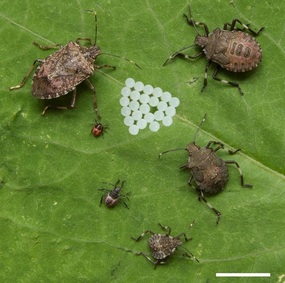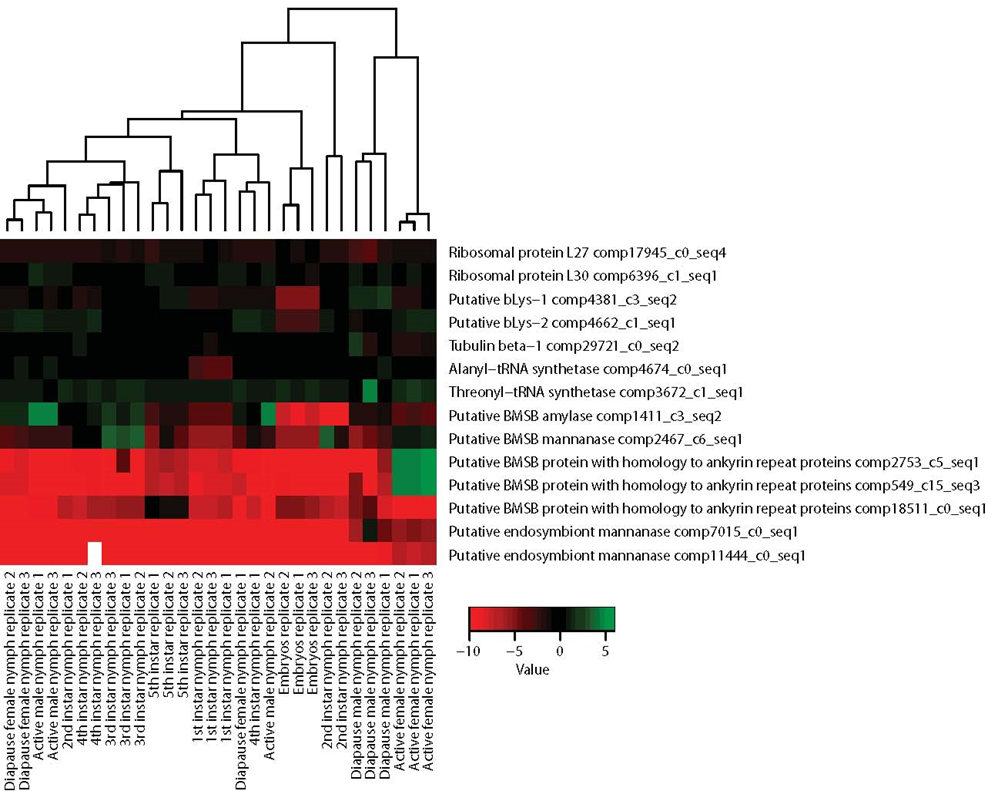How Spiderman got his Powers: A Look into Lateral Gene Transfer“Actually, Spiderman’s powers have nothing to do with radioactivity,” Dr. Julie Dunning Hotopp clarified to the roomful of entomologists. “It was the transfer of spider DNA into his genome.” While the ability to climb walls or shoot webs out your wrists (or worse) is pure science fiction, the transfer of DNA between two different species does actually occur. Dr. Dunning Hotopp explained that this process, known as lateral gene transfer (LGT), is quite widespread and the advent of genome sequencing (determining the chemical code that make an organism unique) in the last decade has greatly expanded our knowledge on the prevalence and role of foreign DNA in animals  (The Brown Marmorated Stink Bug) (The Brown Marmorated Stink Bug) Demonstrating high LGT frequency in invertebrates, Dr. Dunning Hotopp’s team detected LGT from the bacterial endosymbionts Wolbachia in over 30% of sequenced arthropod genomes. Wolbachia is an intracellular bacterial parasite/mutualist with complex host interactions. While LGT from bacteria to animals often has no benefit to a host, in certain cases it can be advantageous. For example, the coffee berry borer, a major pest to coffee growers, and the brown marmorated stink bug both have a gene originally acquired from bacteria. The gene, HhMAN1, codes for the protein mannanse and enables insects to digest plant sugars.
DNA sequence analyses of human tumors suggest that bacterial gene transfer can occur and expand with the tumor. Her research detected bacterial DNA in the human genome more frequently in tumors than normal cells. This means that bacterial DNA could be carcinogenic resulting in cancers such as HPV, acute myeloid leukemia, and stomach cancer. While these findings seem like a promising new avenue for cancer prevention, Dr. Dunning Hotopp cautions that further studies are required to conclusively link the two. About the speaker: Dr. Julie Dunning Hotopp is an Associate Professor in the Institute for Genome Sciences and Department of Microbiology and Immunology at the University of Maryland School of Medicine. Her research focuses on both lateral gene transfer from bacteria to animals as well as bacterial comparative genomics. About the authors: Kevin Ulrich is a graduate student in the Thorne Lab in the Entomology Department at UMD. He is studying the role bed bug chemical secretions play in communication and defense. He will be graduating this May. Jonathan Wang is a graduate student in the St. Leger Lab in the Entomology Department at UMD. He is studying drosophila immunity and fungal pathogenesis. Citations: Acuna, R., B. E. Padilla, C. P. Florez-Ramos, J. D. Rubio, J. C. Herrera, P. Benavides, S.-J. Lee, T. H. Yeats, A. N. Egan, J. J. Doyle, and J. K. C. Rose. "Adaptive Horizontal Transfer of a Bacterial Gene to an Invasive Insect Pest of Coffee." Proceedings of the National Academy of Sciences 109.11 (2012): 4197-202. Web. "The Horrible Truth about Spiderman's Anatomy." Bug Girls Blog. N.p., 25 July 2012. Web. 13 May 2015. Ioannidis, Panagiotis, Yong Lu, Nikhil Kumar, Todd Creasy, Sean Daugherty, Marcus C. Chibucos, Joshua Orvis, Amol Shetty, Sandra Ott, Melissa Flowers, Naomi Sengamalay, Luke J. Tallon, Leslie Pick, and Julie C. Hotopp. "Rapid Transcriptome Sequencing of an Invasive Pest, the Brown Marmorated Stink Bug Halyomorpha Halys." BMC Genomics 15.1 (2014): 738. Web. "Kevinulrich.net." Kevinulrich.net. N.p., n.d. Web. 13 May 2015. Riley, David R., Karsten B. Sieber, Kelly M. Robinson, James Robert White, Ashwinkumar Ganesan, Syrus Nourbakhsh, and Julie C. Dunning Hotopp. "Bacteria-Human Somatic Cell Lateral Gene Transfer Is Enriched in Cancer Samples." PLoS Computational Biology PLoS Comput Biol 9.6 (2013): n. pag. Web. "SOM Faculty Profile : Julie C. Hotopp." SOM Faculty Profile : Julie C. Hotopp. N.p., n.d. Web. 13 May 2015. Comments are closed.
|
Categories
All
Archives
June 2024
|
Department of Entomology
University of Maryland
4112 Plant Sciences Building
College Park, MD 20742-4454
USA
Telephone: 301.405.3911
Fax: 301.314.9290
University of Maryland
4112 Plant Sciences Building
College Park, MD 20742-4454
USA
Telephone: 301.405.3911
Fax: 301.314.9290


 RSS Feed
RSS Feed




